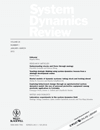
SYSTEM DYNAMICS REVIEW
Scope & Guideline
Advancing knowledge in complex systems dynamics.
Introduction
Aims and Scopes
- Methodological Advancement:
The journal emphasizes innovative methodologies in system dynamics modeling, including the development of algorithms, frameworks, and tools that enhance model analysis and implementation. - Interdisciplinary Applications:
Research published in the journal often applies system dynamics to various fields such as public health, environmental studies, and social sciences, showcasing its versatility in addressing multifaceted issues. - Participatory Modeling:
A significant focus is placed on participatory approaches in system dynamics, emphasizing stakeholder engagement and collaborative modeling to improve decision-making processes. - Policy and Decision Support:
The journal aims to provide insights and tools that support policymakers in understanding complex systems and designing effective interventions. - Educational Methods:
There is a consistent focus on educational strategies for teaching system dynamics, including experiential learning and workshops, to cultivate a new generation of system dynamics practitioners.
Trending and Emerging
- AI and Machine Learning Integration:
There is a rising trend in exploring how artificial intelligence and machine learning can be integrated into system dynamics modeling, enhancing model development and analysis. - Pandemic Preparedness and Response:
Research focusing on system dynamics applications in pandemic scenarios has surged, especially in light of recent global health challenges, highlighting the relevance of dynamic modeling in crisis management. - Causal Loop Diagrams and Qualitative Methods:
An increasing emphasis on qualitative methods, particularly causal loop diagrams, signifies a trend towards understanding complex systems through participatory and visual approaches. - Environmental Sustainability and Climate Dynamics:
Papers addressing sustainability, climate change, and ecological systems are increasingly prominent, reflecting the urgency of these global challenges and the role of system dynamics in developing actionable insights. - Ethical and Social Considerations:
Emerging discussions around the ethical implications of system dynamics modeling, particularly in participatory settings, indicate a growing awareness of the social responsibilities of modelers.
Declining or Waning
- Traditional Economic Modeling:
Papers focusing solely on traditional economic models without integrating system dynamics concepts have become less frequent, indicating a shift towards more complex, holistic approaches to economic issues. - Basic System Dynamics Principles:
There seems to be a declining interest in papers that merely reiterate the foundational principles of system dynamics, as the field moves toward more advanced applications and methodologies. - Single-Disciplinary Focus:
Research that applies system dynamics in isolation from other disciplines is less common, reflecting a trend towards interdisciplinary collaboration that enriches the field. - Static Modeling Approaches:
There is a noticeable decrease in the publication of studies that rely on static models, as dynamic and adaptive modeling techniques gain more attention for their relevance in real-time decision-making. - Narrow Case Studies:
The journal has seen a reduction in narrowly focused case studies that do not generalize findings or contribute to broader theoretical frameworks, suggesting a preference for work that can inform wider applications.
Similar Journals
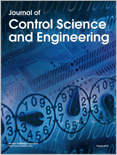
Journal of Control Science and Engineering
Pioneering Research for a Smarter, Controlled FutureThe Journal of Control Science and Engineering, published by HINDAWI LTD, is a prominent open-access journal that has been disseminating pioneering research since 2007. With its ISSN 1687-5249 and E-ISSN 1687-5257, the journal serves as a crucial platform for researchers, professionals, and students engaged in the fields of Computer Science Applications, Electrical and Electronic Engineering, and Modeling and Simulation. Holding a Q3 quartile ranking in 2023 across these categories, the journal maintains rigorous academic standards and is recognized for its contributions to advancing knowledge and technology in control science. The journal's current Scopus rankings highlight its significance, with impressive percentiles placing it within the top tier of its fields. Readers can access a wide range of high-quality research articles through its open access model, further establishing the journal as an essential resource for anyone seeking to broaden their understanding and application of control principles.
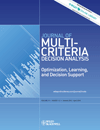
Journal of Multi-Criteria Decision Analysis
Elevating Decision Sciences through Rigorous AnalysisThe Journal of Multi-Criteria Decision Analysis (JMCDM) is a distinguished academic publication dedicated to the interdisciplinary field of decision sciences and management strategies. Published by WILEY, this journal has been a vital resource for researchers and practitioners looking to enhance their understanding of complex decision-making processes since its inception in 1992. The journal is recognized for its rigorous peer-review process and currently holds a Q3 ranking in Decision Sciences (miscellaneous) and a Q2 ranking in Strategy and Management, highlighting its significant contributions to the field. With impressive Scopus rankings, including Rank #19 in General Decision Sciences, JMCDM provides a platform for innovative research that influences theory and practice alike. Although not completely open access, it maintains a robust electronic presence through its E-ISSN: 1099-1360. Researchers, professionals, and students can expect to find comprehensive analyses, methodological advancements, and diverse case studies that support informed decision-making in a variety of contexts.
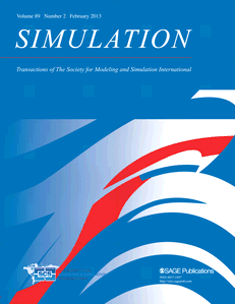
SIMULATION-TRANSACTIONS OF THE SOCIETY FOR MODELING AND SIMULATION INTERNATIONAL
Fostering Collaboration in the World of Modeling and SimulationSIMULATION-TRANSACTIONS OF THE SOCIETY FOR MODELING AND SIMULATION INTERNATIONAL, published by SAGE Publications Ltd, is a pivotal journal in the field of computer graphics, computer-aided design, mathematics, and modeling and simulation. With an ISSN of 0037-5497 and an E-ISSN of 1741-3133, the journal has established itself as a valuable resource since its inception in 1963, boasting a diverse archive leading up to 2024. Ranked in the Q2 category for both Computer Graphics and Mathematics, as well as Q3 for Modeling and Simulation and Software, it reflects a balanced distribution of quality research across multiple disciplines. The journal promotes accessibility through various open access options, ensuring wide dissemination of innovative findings. Researchers, professionals, and students alike will find insightful peer-reviewed articles that delve into advanced simulation methodologies and their applications in real-world scenarios, reinforcing its significant impact on the evolution of the simulation and modeling landscape.
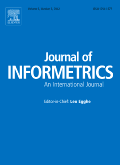
Journal of Informetrics
Innovative Perspectives on Information AnalyticsThe Journal of Informetrics, published by Elsevier, stands as a leading platform for interdisciplinary research in the realms of Applied Mathematics, Computer Science Applications, Library and Information Sciences, Management Science, Operations Research, Modeling and Simulation, and Statistics. Boasting an impressive 2023 impact factor that ranks it in the Q1 category across multiple disciplines, the journal features a robust Scopus ranking of 38/280 in Library and Information Sciences, placing it in the 86th percentile. This esteemed journal, headquartered in the Netherlands, operates without open access, ensuring a curated selection of high-impact research. Since its inception in 2007, the Journal of Informetrics has been pivotal in advancing knowledge and fostering academic discourse, making significant contributions to the study of information metrics and analytics, thereby appealing to researchers, professionals, and students eager to stay at the forefront of this dynamic field.

Systems
Exploring the Frontiers of Systems Engineering and ManagementSystems is an esteemed, peer-reviewed academic journal published by MDPI, focusing on the multifaceted fields of Computer Networks and Communications, Control and Systems Engineering, Information Systems and Management, Modeling and Simulation, and Software. Since its inception in 2013, this Open Access journal strives to disseminate high-quality research that addresses contemporary challenges in system design, analysis, and management across various disciplines. With a dynamic impact factor emerging from its Q3 ranking in several categories and notable Scopus rankings, *Systems* offers a valuable platform for academics, researchers, and industry professionals to share innovative ideas and solutions. Operating from its base in Basel, Switzerland, the journal facilitates unrestricted access to its content, ensuring that pivotal research remains available to a global audience. By fostering collaboration and knowledge exchange, *Systems* plays a crucial role in advancing the theory and application of systems thinking in today’s complex technological landscape.

Journal of Grey System
Unlocking Complex Systems with Applied MathematicsWelcome to the Journal of Grey System, a distinguished publication dedicated to the advanced study of decision sciences, applied mathematics, and statistical theories. Published by Research Information Ltd, this journal has carved out a niche within the academic community, focusing on innovative methodologies and interdisciplinary approaches that foster a deeper understanding of complex systems. Although open access options are not currently available, the journal has been recognized for its scholarly contributions, achieving impressive Scopus rankings—including a notable #47 in Decision Sciences and a 60th percentile rank in Applied Mathematics. With coverage spanning from 2008 to 2019, the Journal of Grey System remains an essential resource for researchers and practitioners aiming to enhance their knowledge in statistics, probability, and system optimization. As a result, it serves not just as a platform for academic discourse but also as a catalyst for future research endeavors in the evolving landscape of mathematical and statistical sciences.

Health Systems
Navigating the complexities of health innovation.Health Systems is a vital journal dedicated to advancing the understanding and application of health system dynamics, innovations, and policies. Published by Taylor & Francis Ltd, this journal has established a reputation as a significant contributor in the fields encompassing Computer Science Applications, Health Informatics, and Health Policy, among others. With a Q3 category ranking in various relevant disciplines and notable percentile rankings in health policy and management sciences, Health Systems serves as a robust platform for researchers and practitioners to publish their findings and foster interdisciplinary dialogues. The journal attracts a diverse audience committed to improving health systems through empirical research and theoretical developments. It continuously evolves, reflecting contemporary challenges and innovations from 2012 to 2024, making it an indispensable resource for those invested in the future of healthcare.

International Journal of Simulation Modelling
Unlocking Insights Through Advanced Simulation MethodologiesInternational Journal of Simulation Modelling, ISSN 1726-4529, published by DAAAM INTERNATIONAL VIENNA, is a premier academic journal dedicated to the fields of modeling and simulation in computer science and applied mathematics. Situated in Austria and housed at the renowned TU WIEN, the journal stands out for its commitment to advancing research and dissemination of innovative simulation methodologies. With an impressive Q2 ranking in both Computer Science Applications and Modeling and Simulation categories as of 2023, it is recognized for its substantial contributions to these domains. This journal, spanning from 2005 to 2024, provides a platform for cutting-edge research that is essential for professionals, researchers, and students seeking to deepen their understanding of simulation techniques and their applications in real-world scenarios. While it is not openly accessible, its invaluable insights and research findings make it a must-read for anyone serious about the advancement of knowledge in simulation modeling.
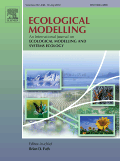
ECOLOGICAL MODELLING
Advancing ecological insights through innovative modeling.ECOLOGICAL MODELLING, published by Elsevier, is a premier international journal dedicated to advancing the field of ecological modeling. Established in 1975, this reputable journal has consistently served as a vital platform for researchers, professionals, and students alike, reflecting the dynamic nature of ecological research and its applications. With an impressive impact factor, currently placing it in the Q2 quartile for Ecological Modeling and in the prestigious Q1 quartile for Ecology, ECOLOGICAL MODELLING ranks prominently in the scientific community, positioned at #91/461 in Environmental Science - Ecology and #14/41 in Environmental Science - Ecological Modeling according to Scopus rankings. The journal seeks to publish high-quality, interdisciplinary research that enhances understanding and predictive capacity regarding ecological processes and their integration into real-world applications. While the journal does not currently offer open access, it remains a cornerstone for knowledge dissemination within the ecological community, ensuring that your valuable research reaches a wide audience.

Nonlinear Engineering - Modeling and Application
Unlocking Complexities in Engineering and ModelingNonlinear Engineering - Modeling and Application is a premier journal dedicated to advancing the fields of engineering, modeling, and simulation, published by De Gruyter Poland Sp. z o.o. since 2012. With an impressive impact factor reflected in its prestigious rankings—Q2 in Chemical Engineering and Miscellaneous Engineering and Q3 in Computer Networks and Communications—this journal serves as an invaluable resource for researchers and practitioners seeking to explore the intricacies of nonlinear systems and their applications. As an Open Access journal since 2019, it ensures that groundbreaking research is readily available to the global community, fostering collaboration and innovation. Situated at the forefront of its field, Nonlinear Engineering provides high-quality, peer-reviewed articles that contribute to understanding complex phenomena in various engineering disciplines, making it an essential publication for those eager to stay on the cutting edge of technology and research.